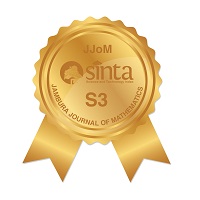Penentuan Premi Tunggal Bersih pada Reversionary Annuity untuk Pasangan Suami Istri dengan Model Frank's Copula
Abstract
Keywords
Full Text:
PDFReferences
H. U. Gerber, Life Insurance Mathematics. Berlin, Heidelberg: Springer Berlin Heidelberg, 1997, doi: http://dx.doi.org/10.1007/978-3-662-03460-6.
E. W. Frees, J. Carriere, and E. Valdez, "Annuity Valuation with Dependent Mortality" The Journal of Risk and Insurance, vol. 63, no. 2, p. 229, jun 1996, doi: http://dx.doi.org/10.2307/253744.
M. Denuit and A. Cornet, "Multilife Premium Calculation with Dependent Future Lifetimes" Journal of Actuarial Practice, vol. 7, pp. 147-180, 1999.
M. Young, "The Mortality of Widowers" The Lancet, vol. 282, no. 7305, pp. 454-457, aug 1963, doi: http://dx.doi.org/10.1016/S0140-6736(63)92193-7.
C. M. Parkes, B. Benjamin, and R. G. Fitzgerald, "Broken Heart: A Statistical Study of Increased Mortality among Widowers" BMJ, vol. 1, no. 5646, pp. 740-743, mar 1969, doi: http://dx.doi.org/10.1136/bmj.1.5646.740.
A. W. Ward, "Mortality of bereavement." BMJ, vol. 1, no. 6011, pp. 700-702, mar 1976, doi: http://dx.doi.org/10.1136/bmj.1.6011.700.
C. Jagger and C. J. Sutton, "Death after marital bereavement-is the risk increased?" Statistics in Medicine, vol. 10, no. 3, pp. 395-404, mar 1991, doi: http://dx.doi.org/10.1002/sim.4780100311.
F. Elwert and N. A. Christakis, "The Effect of Widowhood on Mortality by the Causes of Death of Both Spouses" American Journal of Public Health, vol. 98, no. 11, pp. 2092-2098, nov 2008, doi: http://dx.doi.org/10.2105/AJPH.2007.114348.
P. Margus, "Generalized Frasier Claim Rates Under Survivorship Life Insurance Policies" North American Actuarial Journal, vol. 6, no. 2, pp. 76-94, apr 2002, doi: http://dx.doi.org/10.1080/10920277.2002.10596045.
H. Youn and A. Shemyakin, "Statistical Aspects of Joint Life Insurance Pricing" in Proceedings of Amer. Stat. Assoc. University of St.Thomas: University of St.Thomas, 1999, pp. 34-38.
E. Luciano, J. Spreeuw, and E. Vigna, "Spouses' Dependence across Generations and Pricing Impact on Reversionary Annuities" Risks, vol. 4, no. 2, p. 16, may 2016, doi: http://dx.doi.org/10.3390/risks4020016.
J. F. Carriere, "Bivariate Survival Models for Coupled Lives" Scandinavian Actuarial Journal, vol. 2000, no. 1, pp. 17-32, jan 2000, doi: http://dx.doi.org/10.1080/034612300750066700.
R. J. Cunningham, T. N. Herzog, and R. L. London, Models for Quantifying Risk, 5th ed. Winsted (CT): ACTEX Publications, Inc., 2012.
R. B. Nelsen, An Introduction to Copulas, 2nd ed., ser. Springer Series in Statistics. New York, NY: Springer New York, 2006, doi: http://dx.doi.org/10.1007/0-387-28678-0.
J. De¸bicka, S. Heilpern, and A. Marciniuk, "Application of Copulas to Modelling of Marriage Reverse Annuity Contract" Prague Economic Papers, vol. 29, no. 4, pp. 445-468, aug 2020, doi: http://dx.doi.org/10.18267/j.pep.745.
N. Bowers, H. Gerber, and J. Hickman, Actuarial Mathematics, 2nd ed. Schaumburg (IL): The Society of Actuaries, 1997.
DOI: https://doi.org/10.34312/jjom.v4i2.13952
Copyright (c) 2022 Furlo Gilbert Godfrey, I Gusti Putu Purnaba, Ruhiyat

This work is licensed under a Creative Commons Attribution-NonCommercial 4.0 International License.
Jambura Journal of Mathematics has been indexed by
Jambura Journal of Mathematics (e-ISSN: 2656-1344) by Department of Mathematics Universitas Negeri Gorontalo is licensed under a Creative Commons Attribution-NonCommercial 4.0 International License. Powered by Public Knowledge Project OJS.
Editorial Office
Department of Mathematics, Faculty of Mathematics and Natural Science, Universitas Negeri Gorontalo
Jl. Prof. Dr. Ing. B. J. Habibie, Moutong, Tilongkabila, Kabupaten Bone Bolango, Gorontalo, Indonesia
Email: [email protected].



















